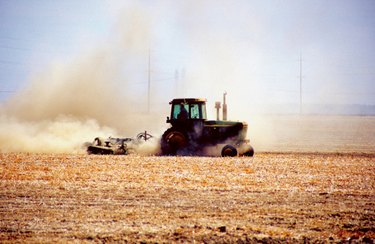
Many farmers have switched from conventional, moldboard plows to chisel plows to till their fields. One of the reasons is versatility. There's only one way to plow with a moldboard plow; chisel plows can be used differently to comply with different needs and conditions.
Fall Tillage
Video of the Day
Chisel plowing in the fall gives you a jump on preparing your fields for spring planting and more. Chiseling incorporates the bulk of the crop residue into the soil to allow the natural processes to break it down, returning the residual nutrients to the soil. It leaves enough residue on the surface to reduce or eliminate wind and water erosion.
Video of the Day
Spring Tillage
Chisel plowing in the spring breaks up the soil, incorporates crop residue, aerates the land and kills early sprouting weeds. In most soils, a follow-up pass with a disk-harrow readies the field for planting seeds.
Compaction
The parts of a field on which harvesting equipment travels frequently is likely to have compacted soil or a compacted layer that prevents rain from infiltrating and plant roots are unlikely to penetrate. A chisel plow run deeply along these travel routes will break up the compaction and allow the crop to grow evenly across the breadth of the field.
Angle Plowing
Conventional plowing, disking, planting and harvesting always involves traveling the same direction up and down the field and over time, the soil tends to reflect these linear farming techniques. Chisel plowing a field at an angle, 20 to 30 degrees from the usual direction, eliminates the linear affect and mixes the field's soil evenly.